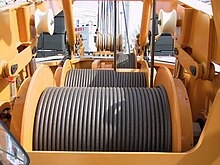Rope winding technology
Rope winding technology , in particular the use of multi-layer rope winding , is a highly developed mechanical method of winding wire ropes in an orderly, exact geometry on a rope drum in multiple layers .
history
In 1937, engineer Frank L. LeBus from Longview , Texas, invented the principle of the grooved rope drums for use on oil production systems . Steel segments provided with a groove shape were simply welded or screwed onto existing steel cable drums. After the manufacturing process patented in 1950 by Lebus Inc., this special grooving is also known as a generic synonym as "Lebus groove".
Areas of application
Since then, the multi-layer rope winding principle has been continuously transferred to other areas of application with a number of innovations, wherever steel ropes of long lengths have to be wound quickly and smoothly in several layers (layers) on top of one another, for example
- on cranes and conveyor systems for the construction industry
- for ship loading and unloading on- and offshore
- in mining
- in oceanography
- at cable cars
The multi-layer technology with parallel grooves on the rope drum makes it possible to wind wire ropes in an orderly, exact geometry in multiple layers. The multi-layer spooling is made possible by special cable grooves milled into the drum body, which run parallel to the outboard pulley (parallel area). The end fillers ensure the correct transition of the rope from layer to layer and thus the intended, exact spool geometry. (Fig. 1)
Two crossing areas offset by approx. 120 ° to 180 °, depending on the purpose or application, ensure the required gradient per revolution of the drum. (Fig. 2) The pyramid-shaped rope structure in the parallel area ensures a constant and stable winding pattern from the first to the last layer. (Fig. 3)
System properties
With the parallel groove, the rope wear is significantly reduced with multi-layer spooling. The load is optimally distributed between the individual layers. End fillers and the parallel grooves prevent the rope from being cut or squeezed. This generally results in a factor of 3 to 5 for the service life of the steel cable. The system enables almost unlimited possibilities for winding wire ropes, regardless of the rope diameter, rope length and rope load.
The system enables the take-up of considerable rope lengths on relatively small drum dimensions by means of multi-layer winding. (Saving of space) Smaller drums mean less use of material, costs and weight. Controlled spooling reduces the risk of failure of the entire system and thus prevents high failure costs. In addition, the controlled, largely maintenance-free winding process ensures the safety of the operating personnel to a high degree.
Delivery forms
Rope drums with the principle of multi-layer rope winding through the parallel groove can either be supplied as complete drums in almost all diameters, or as half-shells that are welded or screwed onto existing drums. This solution offers multiple cost advantages, including a .: In the case of original equipment, the smooth drums can be manufactured in parallel (price and delivery time advantages) and if the rope diameters are changed later, the old drum with new grooves can be used again. At the same time, with the retrofitting of half-shell rope drums, which were previously used in one or two layers, multiple layers can be operated.
equipment
- Cross thread spindle,
- Compensator
The multi-layer rope winding system can be supplemented with a cross-thread spindle (mechanical) or a compensator (automatic) if the angle of contact with the rope drum is too large. In the former, a sprocket drive feeds a cross thread endlessly cut into a shaft and guides the rope from flange to flange via a pulley box or a pulley. In the case of the compensator, a pulley sliding on an eccentric shaft, initiated by the cable pull, is performed in an arc-shaped movement along the winding area.
literature
- Rudolf Becker: The Big Book of Mobile Cranes. Volume 1. Vehicle crane technology manual. 2nd edition, Rene Hellmich KM, 1999, paragraph 2.12, ISBN 978-3-934518-00-1 , p. 50.
- A.Lohrengel, K. Stahr, M. Wächter: Investigations of multi-layer wound rope drums with fiber ropes . No. 36 , 2011, p. 11–20 ( PDF [accessed February 19, 2013]).
- P. Dietz, J. Henschel, I. Mupende, St. Otto, K. Stahr: With Dietz from Albert's wire rope to a lightweight drum . In: IMW - Institute Communication . No. 35 , 2010, p. 77–80 ( PDF [accessed February 19, 2013]).
- Cris Seidenather: fixing fleet angles . In: international cranes . No. 1 , 2013, p. 33–34 ( khl.com [accessed February 23, 2013]).
- Cris Seidenather: keeping it smooth . In: international cranes . No. 10 , 2007, p. 51–53 ( PDF [accessed February 23, 2013]).
Web links
- Increase in rope service life in multi-layer winding in cranes. AiF project 14862 N / 1. (PDF; 82 kB) University of Stuttgart, accessed on February 19, 2013 .
- Technology. Retrieved March 17, 2013 .
Individual evidence
- ↑ Lebus International ( Memento of the original from October 28, 2016 in the Internet Archive ) Info: The archive link was inserted automatically and has not yet been checked. Please check the original and archive link according to the instructions and then remove this notice.
- ↑ a b Dubbel: Pocket book for mechanical engineering . 19th edition. 1997, ISBN 978-3-642-17305-9 , U9 section 2.2.3 Rope pulleys and rope drums ("[...] orderly winding on multi-layer drums up to seven layers using, for example, the Lebus system").





